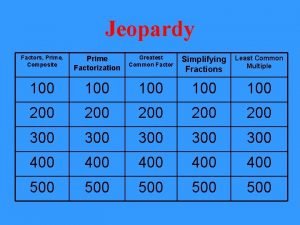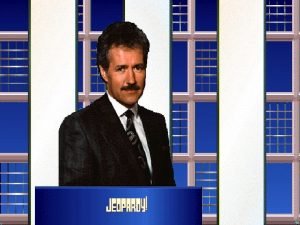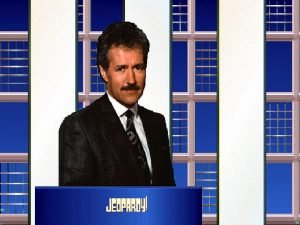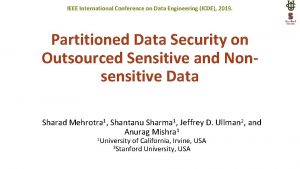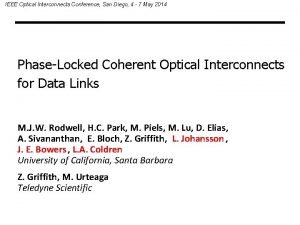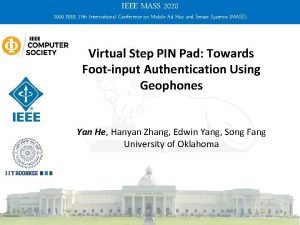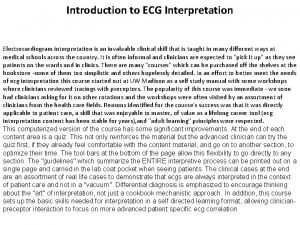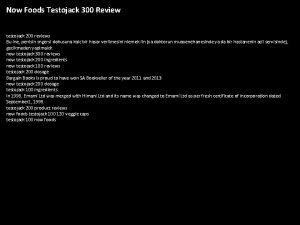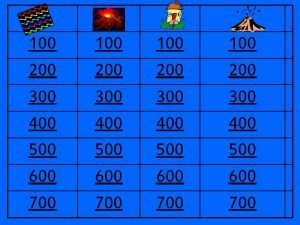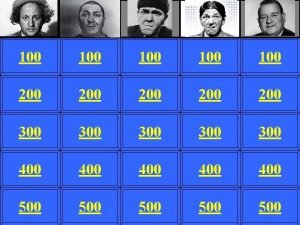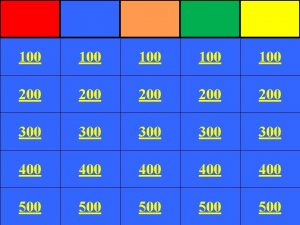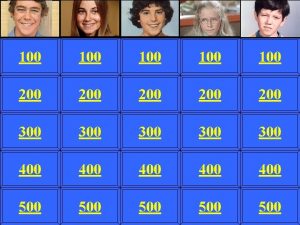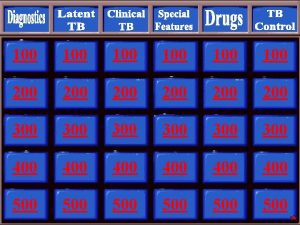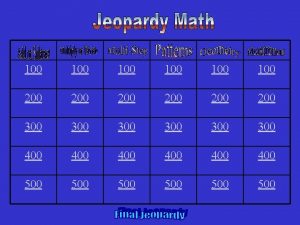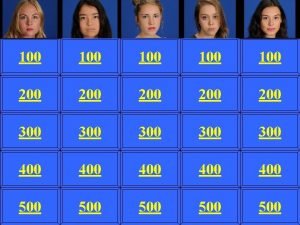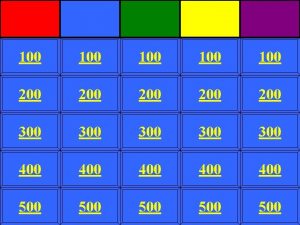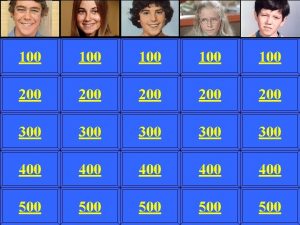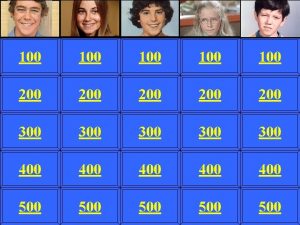THz workshop 2020 IEEE WCNC Conference 100 300




























- Slides: 28

THz workshop, 2020 IEEE WCNC Conference 100 -300 GHz Wireless Mark Rodwell University of California, Santa Barbara Harish Krishnaswami: Columbia University Debdeep Jena, Alyosha Molnar, Christoph Studer, Huili Xing: Cornell University Dina Katabi: MIT Sundeep Rangan: New York University Amin Arbabian, Srabanti Chowdhury: Stanford Elad Alon, Ali Niknejad, Borivoje Nikolic, Vladimir Stojanovic: University of California, Berkeley Danijela Cabric: University of California, Los Angeles Gabriel Rebeiz: University of California, San Diego Jim Buckwalter, Upamanyu Madhow, Umesh Mishra, Mark Rodwell, Susanne Stemmer: University of California, Santa Barbara Andreas Molisch, Hossein Hashemi: University of Southern California Kenneth O: University of Texas, Dallas This work was supported in part by the Semiconductor Research Corporation (SRC) and DARPA. 1

Wireless above 100 GHz Wireless networks: exploding demand. Immediate industry response: 5 G. 28, 38, 57 -71(Wi. Gig), 71 -86 GHz increased spectrum, extensive beamforming Next generation (6 G ? ? ): above 100 GHz. . greatly increased spectrum, massive spatial multiplexing DOD applications: Imaging/sensing/radar, comms. 2

Benefits of Short Wavelengths Communications: Massive spatial multiplexing, massive # of parallel channels. Also, more spectrum! Imaging: very fine angular resolution But: High losses in foul or humid weather. High l 2/R 2 path losses. ICs: poorer PAs & LNAs. Beams easily blocked. 100 -340 GHz wireless: terabit capacity, short range, highly intermittent 3

140 -340 GHz: Applications 4

140 GHz massive MIMO hub demo 1 Tb/s spatially-multiplexed 140 GHz base station 128 users/face, 4 faces. 21 d. Bm PAs, F=8 d. B LNAs 1024 total users @ 1 user/beam, 1, 10 Gb/s/beam; 225, 100 m range in 50 mm/hr rain with 20 d. B total margins Handset: 8 × 8 array (9× 9 mm) 5

220 GHz, 640 Gb/s MIMO Backhaul 8 -element MIMO array 3. 1 m baseline. 80 Gb/s/subarray→ 640 Gb/s total 4 × 4 sub-arrays → 8 degree beamsteering Key link parameters 500 meters range in 50 mm/hr rain; 23 d. B/km 24 d. B total margins: packaging loss, obstruction, operating, design, aging PAs: 24 m. W Pout (per élément) LNAs: 6 d. B noise figure 6

High-resolution imaging radar Goal: MIMO Imaging Radar Carrier Frequencies: 140, 210 GHz 7

ICs 8

In. P HBT to 670 GHz: DARPA TFAST and THz Programs 340 GHz dynamic frequency divider 560 GHz fundamental VCO M. Seo, TSC / UCSB M. Seo, UCSB/TSC IMS 2010 300 GHz fundamen tal PLL M. Seo, TSC 620 GHz, 20 d. B gain amplifier M Seo, TSC IMS 2013 also: 670 GHz amplifier J. Hacker , TSC IMS 2013 (not shown) IMS 2011 204 GHz static frequency divider (ECL master-slave latch) 220 GHz 180 m. W power amplifier 81 GHz 470 m. W power amplifier Z. Griffith, TSC / UCSB CSIC 2010 T. Reed, UCSB CSICS 2013 H-C Park UCSB IMS 2014 Integrated 300/350 G Hz Receivers M. Seo TSC : LNA/Mixer/VC O 600 GHz Integrated Transmitt er M. Seo TSC PLL + Mixer 9

140 GHz CMOS ICs Hub ICs for MIMO Array Farid (Rodwell) UCSB 8 -channel handset array ICs; transmitter and receiver (Rebeiz group), UCSD 10

Progress in IC Design: 140 GHz In. P PAs 110 m. W power amplifier, 20. 8% PAE A. Ahmed, IMS 2020 190 m. W power amplifier A. Ahmed, submitted. Also: "A 130 -GHz Power Amplifier in a 250 -nm In. P Process with 32% PAE" Kang Ning (Buckwalter group) 2020 RFIC symposium 11

Packages / array modules 12

The mm-wave module design problem How to make the IC electronics fit ? How to avoid catastrophic signal losses ? How to remove the heat ? Not all systems steer in two planes. . . some steer in only one. Not all systems steer over 180 degrees. . . some steer a smaller angular range 13

Concept: Tile for linear arrays Terrestrial system: horizontal steering only→ linear array. Space at edges of linear array: room for III-V PAs, LNAs. Alternating-sides feed: 2 mm pitch→ room for large Ga. N PAs. Mounting directly on metal carrier→ heatsinking. 14

Concept: module for small angular scanning Terrestrial system: horizontal + vertical steering → rectangular array. Limited angular steering range (installation)→ spacing >> l/2 Endfire / edge-card geometry: room for III-V PAs, LNAs. Mounting directly on metal carrier→ heatsinking. If Vivaldi's are replaced with dipoles, element spacing can be reduced to l/2. → potential for wider angular scanning 15

140 GHz array module design -1. 4 d. B -0. 53 d. B Simulations good: working with Kyocera. June tapeout ? 16

Systems 17

Beamforming for massive spatial multiplexing Pure digital beamforming: dynamic range & phase noise requirements: appear to be manageable Digital back-end processing requirements (die area, DC power): being investigated ? Analog, hybrid beamforming: Do not appear to significantly improve dynamic range in massive MIMO. 18

Progress in System Design Digital beamforming ADCs/DACs: only 3 -4 bit ADC/DACs required (Madhow, Studer, Rodwell) Linearity: Amplifier P 1 d. B need be only 3 d. B above average power (Madhow). Phase noise: Requirements same as for SISO (Alon, Madhow, Niknejad, Rodwell) Efficient digital beamforming: beamspace algorithm=complexity ~N× log(N) (Madhow) Efficient digital beamforming: low-resolution matrix (Studer) Efficient channel estimation : fast beamspace algorithm (Studer) Efficiently addressing true-time-delay problem: "rainbow" FFT algorithm (Madhow) Array-to-backplane interconnect power: low-power analog baseband 50 W links (Rodwell) In progress… Propagation models and measurements: (Molisch) Blockage probability, mesh networks, network protocols: (Rangan, Cabric) MIMO system power analysis: (Rangan, Cabric, Buckwalter) 19

Progress: All-Digital Beamformer • mm. Wave/THz channels are sparse in beamspace domain • Exploiting sparsity can significantly reduce baseband complexity • Challenge: requires fast Fourier transforms (FFTs) at baseband sampling rates • Implementation examples – 1 GHz bandwidth – 10 b FFTs generated with Spiral • Specialized FFTs (radix-4, higher streaming width, etc. ) will further reduce area and power! Christoph Studer, Cornell BS antennas Area Power 64 9 mm 2 2 W 128 32 mm 2 7 W 256 122 mm 2 26 W Synthesis results for 28 nm CMOS 20

Transistors 21

Progress in mm-Wave Transistors In. Ga. N and Ga. N HEMTs: High power from 100 -340 GHz Ga. N: superior power density at all frequencies UCSB/Mishra: In. Ga. N for increased mobility Cornell/Xing: Al. N/Ga. N/Al. N N-polar Ga. N: Mishra, UCSB THz In. P HBTs: SOA today: 130 nm node, 1. 1 THz fmax, 3. 5 V breakdown Efficient 100 -650 GHz power more fmax: more efficient, higher frequencies base regrowth: better contacts→ higher fmax. status: working DC devices; moving to THz In. P HBTs: SOA today: 1. 5 THz fmax, ~1. 1 V breakdown Sensitive 100 -650 GHz low-noise amplifiers more ft: lower noise, higher frequencies high-K gate dielectric → higher ft. status: process modules 22

Wireless above 100 GHz Massive capacities large available bandwidths massive spatial multiplexing in base stations and point-point links Very short range: few 100 meters short wavelength, high atmospheric losses. Easily-blocked beams. IC Technology All-silicon for short ranges below 250 GHz. III-V LNAs and PAs for longer-range links. Just like cell phones today III-V frequency extenders for 340 GHz and beyond The challenges spatial multiplexing: computational complexity packaging: fitting signal channels in very small areas 23

(backup files follow) 24

Progress in System Design ADC resolution: N ADC bits, M antennas, K signals: SNR=6 N+1. 76+10. log 10(M/K) 3 bits, (M/K)=2→ SNR=23 d. B. QPSK needs 9. 8 d. B. Jammer tolerance: Increase ADC resolution by 1 bit→ Pjammer, max = K. Psignal Maximum jammer power = sum of all user's power. Phase noise: Phase error sf : SNR= -20. log 10(sf)+10. log 10(M/K), where MIMO and SISO require similar L(f). Beamspace: lower frequencies, many NLOS paths, complicated channel matrix: O(M 3) to beamform higher frequencies, few NLOS paths, simpler channel matrix: FFT, O(M. log. M) to beamform fewer bits in signal; fewer bits in FFT coefficients. 25

The mm-wave module design problem How to make the IC electronics fit ? 100+ GHz arrays: l 0/2 element spacing is very small. Antennas on or above IC → IC channel spacing = antenna spacing → limited IC area to place circuits How to avoid catastrophic signal distribution losses ? long-range, high-gain arrays: array size can be large. ICs beside array → very long wires between beam former and antenna → potential for very high signal distribution losses How to remove the heat ? 100+ GHz arrays: element spacing is very small. If antenna spacing = IC channel spacing, then power density is very large 26

Com. Sen. Ter Center for Converged Communications & Sensing at THz. Duration: 5 -years; 1/2018 -12/2022. Funding: about $32 million total. Team: 21 Professors, ~65 Ph. D. students Sponsors: SRC, DARPA Focus: wireless systems, 10 -15 years out, 100 -340 GHz 27

100 -340 GHz: challenges & solutions High attenuation in foul or humid weather Need mesh networks Need large arrays 28
 100 100 100 100 100
100 100 100 100 100 Thz hannover
Thz hannover Boris n
Boris n 300 + 300 + 200
300 + 300 + 200 Factor jeopardy
Factor jeopardy 200+100+300
200+100+300 200 300 300
200 300 300 300+200+200+200
300+200+200+200 300+300+400
300+300+400 300+300+400
300+300+400 300 + 300 + 400
300 + 300 + 400 300+300+400
300+300+400 400 + 300 + 300
400 + 300 + 300 300 300 400
300 300 400 What the font
What the font 100 + 200 300
100 + 200 300 Icde 2019
Icde 2019 Ieee optical interconnects conference
Ieee optical interconnects conference Ieee mass 2020
Ieee mass 2020 300 150 100 ekg
300 150 100 ekg Wandering atrial pacemaker ecg
Wandering atrial pacemaker ecg 100 200 300 400 500 600 700 800 900 1000
100 200 300 400 500 600 700 800 900 1000 200+200+100
200+200+100 Testojack reviews
Testojack reviews 100 200 300 400
100 200 300 400 100 200 300 400 500
100 200 300 400 500 100+200+300+400
100+200+300+400 100 200 300 400 500 600
100 200 300 400 500 600 100 200 300 400
100 200 300 400




